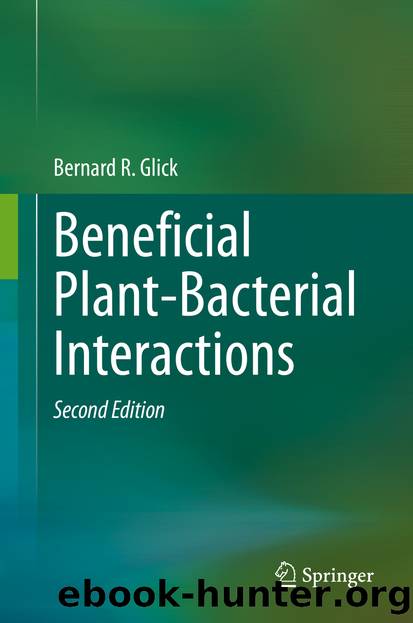Beneficial Plant-Bacterial Interactions by Bernard R. Glick

Author:Bernard R. Glick
Language: eng
Format: epub
ISBN: 9783030443689
Publisher: Springer International Publishing
Unlike phytopathogens, plants are not generally affected by the localized depletion of iron in the soil caused by the siderophores that are produced by biocontrol PGPB. This is because most plants are able to grow at much lower iron concentrations than most microorganisms. In addition, many plants can bind and take up the biocontrol PGPB iron–siderophore complex, transport it through the plant, and then reductively release the iron from the bacterial siderophore so that the iron can be used by the plant.
The ability of siderophores to act as effective “disease-suppressive” agents is affected by the particular crop plant, the specific phytopathogen being suppressed, the soil composition (including the nutrients and the microorganisms), the bacterium that synthesizes the siderophore, and the affinity of the specific siderophore in question for iron. All of these possible variables suggest that even though a particular biocontrol PGPB is an effective disease-suppressive agent in the laboratory, its behavior in the field may be much more difficult to predict.
In addition, to the type of experiment shown in Fig. 6.6, several genetic studies of siderophore-producing PGPB are consistent with the involvement of siderophores in the suppression of disease caused by fungal and bacterial pathogens. Thus, researchers have shown that siderophore overproducing mutant PGPB strains are often more effective than the wild-type bacterium in controlling specific pathogens. Moreover, mutant strains of biocontrol PGPB that were selected for their loss of siderophore production concomitantly lost the ability, displayed by the wild-type strain, to protect tomato plants against damage from specific phytopathogens. In another study, it was observed that a single Tn5 insertion into the genome of the biocontrol PGPB Alcaligenes sp. strain MFA1 resulted in the simultaneous loss of the ability of the bacterium to grow in the absence of added iron, and to inhibit growth and development of the fungal pathogen Fusarium oxysporum.
It may be possible to improve biocontrol PGPB by extending the range of iron–siderophore complexes that a particular PGPB strain can utilize. In this case, a genetically altered biocontrol PGPB strain could take up and use siderophores that are synthesized by other soil microorganisms thereby giving it a competitive advantage in the soil environment. It has been observed that some Pseudomonas spp. strains naturally possess from 5 to 20 outer membrane receptors, each of which can recognize and take up a single siderophore, or a set of siderophores with very similar structures. These siderophore receptors allow these strains to proliferate in the soil, and especially in the rhizosphere, at the expense of other soil bacteria.
Download
This site does not store any files on its server. We only index and link to content provided by other sites. Please contact the content providers to delete copyright contents if any and email us, we'll remove relevant links or contents immediately.
| Automotive | Engineering |
| Transportation |
Whiskies Galore by Ian Buxton(41879)
Introduction to Aircraft Design (Cambridge Aerospace Series) by John P. Fielding(33064)
Small Unmanned Fixed-wing Aircraft Design by Andrew J. Keane Andras Sobester James P. Scanlan & András Sóbester & James P. Scanlan(32743)
Craft Beer for the Homebrewer by Michael Agnew(18140)
Turbulence by E. J. Noyes(7936)
The Complete Stick Figure Physics Tutorials by Allen Sarah(7307)
Kaplan MCAT General Chemistry Review by Kaplan(6867)
The Thirst by Nesbo Jo(6826)
Bad Blood by John Carreyrou(6552)
Modelling of Convective Heat and Mass Transfer in Rotating Flows by Igor V. Shevchuk(6391)
Learning SQL by Alan Beaulieu(6211)
Weapons of Math Destruction by Cathy O'Neil(6146)
Man-made Catastrophes and Risk Information Concealment by Dmitry Chernov & Didier Sornette(5921)
Digital Minimalism by Cal Newport;(5664)
Life 3.0: Being Human in the Age of Artificial Intelligence by Tegmark Max(5474)
iGen by Jean M. Twenge(5366)
Secrets of Antigravity Propulsion: Tesla, UFOs, and Classified Aerospace Technology by Ph.D. Paul A. Laviolette(5309)
Design of Trajectory Optimization Approach for Space Maneuver Vehicle Skip Entry Problems by Runqi Chai & Al Savvaris & Antonios Tsourdos & Senchun Chai(5011)
Pale Blue Dot by Carl Sagan(4912)
